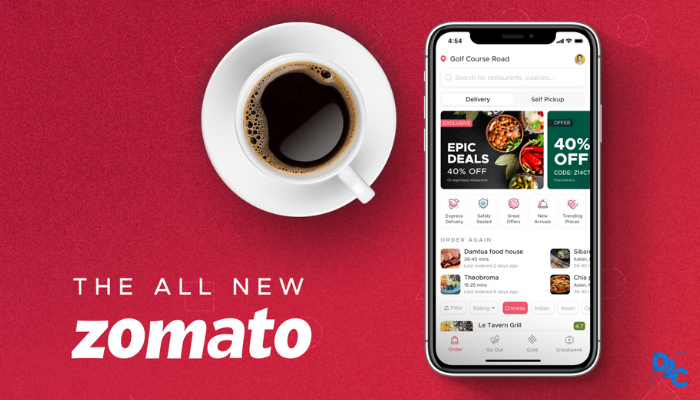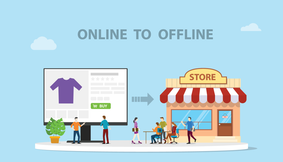The rise and rise of Zomato - A case study

In the early 2000s, we weren’t accustomed to using our phones for purposes other than calling and text messaging. In fact, most of us were oblivious to the opportunities that this magic box could present! The end of the first decade of the century brought with it a revolution like no other. And it was during those crucial years of transformation when the foundation of the largest food aggregator in India was laid. Yes, we are talking about Zomato!
The launch of Foodiebay
Unlike Rome, the idea of starting something like Zomato was actually built in a day. One fine morning, Pankaj Chaddah and Deepindar Goyal were in their office in Delhi when they witnessed a sight that later changed the fate of countless people! What they saw was nothing spectacular or different but a mere routine of many people where they would have to wait in line for a long time, just to catch a glimpse of the menu card.
It was in that exact moment, that the idea of creating Zomato cultivated in the duo’s minds. The seed was sown but the problem couldn't have been solved in a day. So, they started with uploading soft copies of menu cards on their website. In the beginning, it quickly gained popularity in their office and soon enough the word spread and it became a well-known website in the entire city.
Zomato, founded by Deepinder Goyal and Pankaj Chaddah in the year 2008, was famous as Foodiebay in the initial years. In a matter of mere nine months, the company earned fame throughout the country and turned into the largest restaurant directory in Delhi NCR. What initially started in Delhi, later extended to cities like Kolkata and Mumbai.
It was only in 2010 when Foodiebay gathered a huge user base and brought in investors, the founders decided to modify the company’s name and take it international. This is where the venture was rechristened as Zomato. Thus began the roller coaster journey of the company.
How word spread around the world
Zomato witnessed a steep upward curve in its growth. This can also be attributed to the fact that it took no time to spread its wings and acquire a place for itself in other parts of the country and beyond. Soon after it earned fame in Delhi NCR, the company branched out to cities like Ahmedabad, Pune, Bengaluru, Hyderabad and Chennai.
By the year 2012, Zomato had commenced its overseas expansion by extending its services to UAE, Sri Lanka, South Africa, Qatar, the Philippines and UK. The year 2013 added Turkey, Brazil and New Zealand to its palette.
But Zomato did not stop here. It worked on its tech to match the exponential rise of smartphones and launched its app. Not only this, the company went a step further to aggressively acquire foreign competition in order to increase its foothold in countries around the world. In 2014, the firm took over Poland’s restaurant search service, Gastronauci, and an Italian restaurant finder, Cibando. The very next year brought with it, its biggest acquisition - NexTable, the US-based online table reservation platform. And soon after, it went ahead and acquired Urbanspoon, another US-based restaurant directory, but had to shut its app within a span of five months.
Revolutionizing the door-to-door delivery system
The food delivery sector in India has been the centre of attention for investors, much like its peers across the globe. In the past few years, copious amounts of capitals have chased both Swiggy and Zomato. In this regard, Zomato has about 1,50,000 listings from India out of the 1.4 million listings that it has globally. The platform in India witnesses 22 million users every two months who haven’t previously tried its delivery service.
Zomato is looking to convert this opportunity, even if it is only a fraction of it, to scale its business of food delivery. When asked Deepinder Goyal about it, he stated that about 5% (out of the 22 million new users) try food delivery every month and that acquisition comes at no-cost. Basis this, food delivery, for Zomato, is not a standalone business but rather comes from the ecosystem benefit it has.
As far as food delivery is concerned, Zomato charges a commission to restaurants which relies on the number of orders. Where users pay delivery fees, Zomato earns via restaurants who pay commission to the company for every delivery. This fee is then split amongst the company and the delivery partner/s. These commissions differ from one restaurant to another based on whether the restaurant uses its own riders or Zomato carries out the said delivery. In a small way, this amount contributes to the net income of the company.
Facing the troughs
The graph of Zomato, that looks excellent this far, did not stay the same post 2014. The year 2015 brought with it hardships of all kinds and it was then that the company had to make some harsh decisions. After acquiring Urbanspoon and rebranding it as its own, the venture failed miserably, so much, that the company was forced to lay off 300 employees to curb its losses, 10% of which were from the US.
By 2016, things went out of hand to an extent that Zomato had to roll back its operations in various countries like the US, UK, Brazil, Chile, Sri Lanka, Canada, Italy, Slovakia, and Ireland. And when it finally resumed its operations in the said countries, Zomato had to work with remote services.
There’s more lined up in their story. Zomato faced a major setback in the year 2017 when its existence was put at stake with a cyber attack. A hacker had breached into the records of 17 million users from the database of the company. Soon after, Zomato understood that the data could only be accessed by the hacker and the breach was resolved after communicating with the hacker. As it later turned out, the hacker was only trying to prove a point that there existed security loopholes in the system.
Consequently, in the year 2019, a campaign called #logout surfaced where restaurants listed on the platform called the company out for eating their profit margins via its features like Infinity Dining and Zomato Gold, which provided heavy discounts to customers. Amidst tremendous protests from its partnered restaurants and layoffs in the company, Zomato discontinued its Infinity dining service and revised the Zomato Gold rules post which the matter subsided.
But even after all of this, the spirit of Zomato stays intact which is quite aptly depicted in its tagline - “Never have a bad meal”. To top it all, Zomato registered a rise of 177% in its restaurant partners and got 73K more restaurants on board. Today, Zomato has close to 119K restaurants in comparison to that of 43K in 2019.
What lies beyond?
If we go by numbers, Zomato witnessed a record rise of 225% in its revenue in the very first half of FY2020. The company’s biannual report revealed that it had registered $205 Mn in revenue as compared to $63 Mn (in the first half) of last year.
Zomato’s journey thus far has witnessed crests and troughs of its own. But it wouldn’t be wrong to say that ups and downs are faced by almost all startup companies in their initial years. What really matters, in the end, is their resilience, their will to stand by the organization and its values and the decisions they make in difficult situations.
As for the founders, Deepindar and Pankaj, they’ve done a phenomenal job of keeping Zomato afloat even in times of crisis. Where in early 2018, Pankaj announced that he’d like to quit Zomato and take some time off before he turned “professionally active” again, he continues to hold a stake of 3.11% in the organization.
Today, the company is looking forward to raising more funds with a vision to expand its service portfolio. It aims to reach newer markets and explore other related domains of growth. As Zomato battles it out with Swiggy - its biggest competitor, it will be interesting to see what lies ahead for this organization especially in a time when bigger players are entering the market.
Login to continue reading
And access exclusive content, personalized recommendations, and career-boosting opportunities.
Blogs you need to hog!

What Innovation Does For Efficiency and Competitiveness in a Corporate Sector?

Online to Offline Commerce- Everything one needs to know

How Do You Work Around Branding Guidelines To Be Guidelines And Not Limitations? | Alekhya, Brand Manager- Vivel, ITC | Dove, Unilever













Comments
Add comment